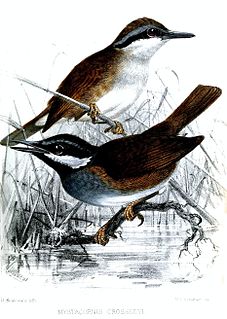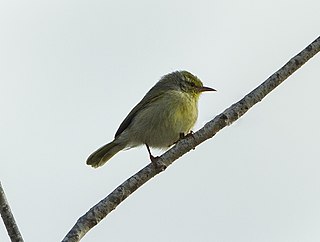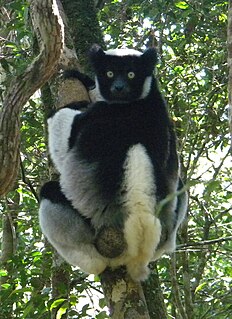
The family Vangidae comprises a group of often shrike-like medium-sized birds distributed from Asia to Africa, including the vangas of Madagascar to which the family owes its name. Many species in this family were previously classified elsewhere in other families. Recent molecular techniques made it possible to assign these species to Vangidae, thereby solving several taxonomic enigmas.

The Madagascar lowland forests or Madagascar humid forests are a tropical moist broadleaf forest ecoregion found on the eastern coast of the island of Madagascar, home to a plant and animal mix that is 80 to 90% endemic, with the forests of the eastern plain being a particularly important location of this endemism. They are included in the Global 200 list of outstanding ecoregions.

The Madagascar subhumid forests are a tropical moist broadleaf forest ecoregion that covers most of the Central Highlands of the island of Madagascar. They are included in the WWF's Global 200 list of outstanding ecoregions. Most of the original habitats have been lost due to human pressure.

Ankarana Special Reserve in northern Madagascar was created in 1956. It is a small, partially vegetated plateau composed of 150-million-year-old middle Jurassic limestone. With an average annual rainfall of about 2,000 millimetres (79 in), the underlying rocks have been eroded to produce caves and feed subterranean rivers—a karst topography. The rugged relief and the dense vegetation have helped protect the region from human intrusion.

Ankarafantsika National Park is a national park near Andranofasika in the Boeny Region of Madagascar. The closest city is Majunga 115 kilometres (71 mi) north of the park. Ankarafantsika is mostly tropical in climate type. The Sakalava people are the predominant ethnic group living and farming here. The greater big-footed mouse lives in the park and is not known anywhere else.

The Tetrakas and allies are a newly validated family of songbirds. They were formally named Bernieridae in 2010. The family currently consists of eleven species of small forest birds. These birds are all endemic to Madagascar.

The wedge-tailed jery is a small bird endemic to the east of Madagascar. The species has been the cause of some taxonomic confusion, it was originally placed with the jeries in the genus Neomixis (Cisticolidae) before being placed in its own monotypic genus Hartertula, but still considered close to Neomixis. Recent research indicates it is part of an endemic Malagasy radiation currently known as the Malagasy warblers.

The long-billed bernieria, formerly known as long-billed greenbul and sometimes as common tetraka or long-billed tetraka, is a songbird species endemic to Madagascar. It was initially considered a greenbul, and later with the Old World warblers. Recent research indicates it is part of the endemic Malagasy radiation Bernieridae.
The Madagascan yellowbrow, also known as the yellow-browed oxylabes, is a species of Malagasy warbler, formerly placed in the family Sylviidae. Found only in Madagascar, it is the sole member of the genus Crossleyia. Its natural habitat is subtropical or tropical moist montane forests. It is threatened by habitat loss.

Crossley's vanga, also known as Crossley's babbler-vanga, Crossley's babbler, Madagascar groundhunter, or Madagascar groundjumper, is a bird species in the family Vangidae.

The common jery is a species of bird in the family Cisticolidae. It is endemic to Madagascar.
The green jery is a species of bird in the family Cisticolidae. It is endemic to Madagascar.

The Malagasy paradise flycatcher is a species of bird in the family Monarchidae. It is found in Comoros, Madagascar, and Mayotte. Its natural habitats are subtropical or tropical dry forest and subtropical or tropical moist lowland forest.

Pollen's vanga is a species of bird in the family Vangidae. It is endemic to eastern Madagascar. Its natural habitats are subtropical or tropical moist lowland forests and subtropical or tropical moist montane forests. It is threatened by habitat loss.

Lafresnaye's vanga is a species of bird in the vanga family Vangidae. The species is monotypic and one of three species in the genus Xenopirostris. It is endemic to the south and south west of Madagascar. It inhabits sub-arid thorn scrub, in the Madagascar spiny forests ecoregion, particularly areas with large amounts of dead wood, from sea level to 100 m (330 ft). The species has a small range and is not common within that range, but is not thought to be endangered and is listed as Least Concern by the IUCN.

The rufous-headed ground roller is a species of bird in the ground roller family, Brachypteraciidae. It is endemic to Madagascar. There are currently five known species of ground rollers. Four of these species live in the eastern and central highland humid forests. Unlike the four other species, the fifth species lives in the dry southwestern spiny bushes of Madagascar. The Atelornis crossleyi species of the ground rollers lives with most of its family in humid forests. The International Union for Conservation of Nature considers the bird to be near-threatened because, although it is present in a number of protected areas, it is hunted for food and the forests in which it lives are threatened by slash-and-burn cultivation. The bird's scientific name commemorates Alfred Crossley who collected mammals, birds, butterflies and moths in Madagascar and Cameroon in the 1860s and 1870s. Many of these are in the Natural History Museum, London.

Zahamena National Park is a national park of Madagascar. Established in 1997, it covers an area of 423 square kilometres (163.32 sq mi) out of a total protected area of 643 square kilometres (248.26 sq mi). It is part of a UNESCO World Heritage Site, Rainforests of the Atsinanana, inscribed in 2007 and consisting of 13 specific areas located within eight national parks in the eastern part of Madagascar. In 2001, Bird Life International assessed avifauna of 112 species of which 67 species are exclusively endemic to Madagascar.
Ambatovaky Reserve is a tropical rainforest and wildlife reserve in the north-east of Madagascar. It is designated by Bird Life International as an Important Bird Area for the large number of endemic species of birds.
Maningoza Special Reserve is a 9,826 hectares wildlife reserve in Madagascar. It was created in 1956 to protect the many endemic plants and animals, and it also contains some of the last remaining areas of dry deciduous forest on the island.

Tsitongambarika is a lowland forest in southern Madagascar. The area supports many rare species of amphibians, birds, lemurs and reptiles; many of which are endemic. In 2001, the site was designated as an Important Bird Area by BirdLife International and in 2015, an area of 600 km² received environmental protection by the government. The reserve is the recipient of monies raised by the 2016 Rutland Birdfair.

















